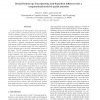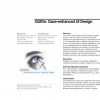86 search results - page 10 / 18 » Guiding Visual Surveillance by Tracking Human Attention |
CVPR
2007
IEEE
14 years 9 months ago
2007
IEEE
A critical function in both machine vision and biological vision systems is attentional selection of scene regions worthy of further analysis by higher-level processes such as obj...
CHI
2005
ACM
13 years 9 months ago
2005
ACM
The Restricted Focus Viewer (RFV) relates a small part of an otherwise blurred display to the focus of visual attention. A user controls which part of the screen is in focus by us...
CHI
2007
ACM
14 years 7 months ago
2007
ACM
The GUIDe (Gaze-enhanced User Interface Design) project in the HCI Group at Stanford University explores how gaze information can be effectively used as an augmented input in addi...
KI
2010
Springer
13 years 6 months ago
2010
Springer
Most approaches to the visual perception of humans do not include high-level activity recognitition. This paper presents a system that fuses and interprets the outputs of several c...
ICCV
2005
IEEE
14 years 1 months ago
2005
IEEE
Abstract. Visual detection and tracking of humans in complex scenes is a challenging problem with a wide range of applications, for example surveillance and human-computer interact...


